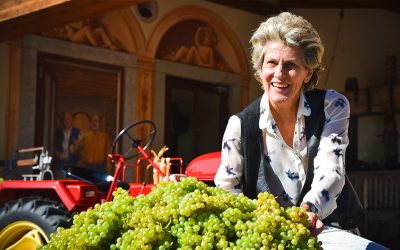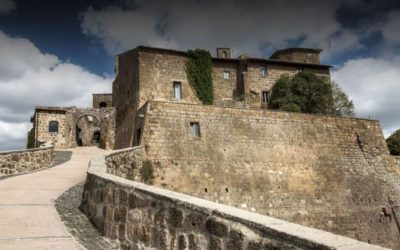 Il più importante (e imponente) monumento della città di Prato è il Duomo, opera che ha il suo nucleo originale nella pieve (probabilmente del V secolo) di Santo Stefano; la sua costruzione iniziò nel XII secolo e rappresenta uno dei migliori esempi italiani di chiesa romanico-gotica. Sempre nel medesimo secolo, risale anche la costruzione del chiostro romanico, modificato in parte solo nel XV secolo. E' del 1200 invece l'adiacente campanile, struttura che ha preso vita da un progetto di Guidetto da Como, terminato poi definitivamente nel 1356-7 con la cella a trifore. L'attuale facciata (rivestita in pietra alberese e marmo verde di Prato) risale al 1386 (di Lorenzo di Filippo), sarà completata definitivamente solo verso la metà del XV secolo, stesso periodo tra l'altro a cui risale sia il grande portale con la lunetta decorata da una terracotta invetriata di Andrea della Robbia, sia il pulpito esterno di Donatello (l'originale del parapetto è attualmente conservato nel Museo dell'Opera del Duomo). L'interno del Duomo è a tre navate e, oltre ad essere caratterizzate da possenti colonne di marmo verde con raffinati capitelli, qui vengono usate per la prima volta in un interno delle decorazioni a fasce bicrome. All'inizio della navata sinistra è situata la trecentesca Cappella della Sacra Cintola, realizzata per conservare la reliquia mariana e chiusa da una cancellata bronzea quattrocentesca. Il transetto (1317-1368) è attribuito a Giovanni Pisano, il pulpito a calice (XV secolo), a Mino da Fiesole e Antonio Rossellino. A livello di dipinti il Duomo è un vero mercato d'arte di squisita fattura: cicli di affreschi ricoprono la Cappella Maggiore con le Storie dei Santi Stefano e Giovanni Battista eseguiti da Filippo Lippi e collaboratori (1452-65); nella cappella della Sacra Cintola, le Storie della Vergine e della Sacra Cintola (1392-95) di Agnolo Gaddi e bottega; nella cappella dell'Assunta, le Storie della Vergine e di Santo Stefano concordemente assegnate a Paolo Uccello. Ed ora la lezione di scultura: i tre fratelli da Maiano "espongono dal 1480" il Tabernacolo della Madonna dell'Ulivo, Giovanni Pisano ci offre la Madonna con Bambino. Chi si offre volontario per la visita guidata?
Il più importante (e imponente) monumento della città di Prato è il Duomo, opera che ha il suo nucleo originale nella pieve (probabilmente del V secolo) di Santo Stefano; la sua costruzione iniziò nel XII secolo e rappresenta uno dei migliori esempi italiani di chiesa romanico-gotica. Sempre nel medesimo secolo, risale anche la costruzione del chiostro romanico, modificato in parte solo nel XV secolo. E' del 1200 invece l'adiacente campanile, struttura che ha preso vita da un progetto di Guidetto da Como, terminato poi definitivamente nel 1356-7 con la cella a trifore. L'attuale facciata (rivestita in pietra alberese e marmo verde di Prato) risale al 1386 (di Lorenzo di Filippo), sarà completata definitivamente solo verso la metà del XV secolo, stesso periodo tra l'altro a cui risale sia il grande portale con la lunetta decorata da una terracotta invetriata di Andrea della Robbia, sia il pulpito esterno di Donatello (l'originale del parapetto è attualmente conservato nel Museo dell'Opera del Duomo). L'interno del Duomo è a tre navate e, oltre ad essere caratterizzate da possenti colonne di marmo verde con raffinati capitelli, qui vengono usate per la prima volta in un interno delle decorazioni a fasce bicrome. All'inizio della navata sinistra è situata la trecentesca Cappella della Sacra Cintola, realizzata per conservare la reliquia mariana e chiusa da una cancellata bronzea quattrocentesca. Il transetto (1317-1368) è attribuito a Giovanni Pisano, il pulpito a calice (XV secolo), a Mino da Fiesole e Antonio Rossellino. A livello di dipinti il Duomo è un vero mercato d'arte di squisita fattura: cicli di affreschi ricoprono la Cappella Maggiore con le Storie dei Santi Stefano e Giovanni Battista eseguiti da Filippo Lippi e collaboratori (1452-65); nella cappella della Sacra Cintola, le Storie della Vergine e della Sacra Cintola (1392-95) di Agnolo Gaddi e bottega; nella cappella dell'Assunta, le Storie della Vergine e di Santo Stefano concordemente assegnate a Paolo Uccello. Ed ora la lezione di scultura: i tre fratelli da Maiano "espongono dal 1480" il Tabernacolo della Madonna dell'Ulivo, Giovanni Pisano ci offre la Madonna con Bambino. Chi si offre volontario per la visita guidata?
The most important (and imposing) monument of Prato is the Cathedral, a online casino texas holdem building that originated from the parish church (probably dating back to the fifth century) of St Stephen. The cathedral was begun in the twelfth century and is one of the best Italian examples of a Romanesque-Gothic church. In the same century, the Romanesque cloister was also built; it was only partly modified in the fifteenth century. The adjacent bell tower dates back to the thirteenth century; this was built to the design of Guidetto da Como and was finally completed in 1356-7 with the three-mullioned window cell. The actual fa�ade (covered in pietra alberese and green marble of Prato), dating back to 1386 (by Lorenzo di Filippo), was only totally finished towards the middle of the fifteenth century, the same period as the great portal with the lunette decorated with glazed terracotta by Andrea della Robbia and the external pulpit by Donatello (the original of the parapet is currently kept in the Cathedral Museum). The interior of the three-nave cathedral features imposing columns of green marble with elegant capitals which are used for the first time in an interior with two-colour striped decorations. At the beginning of the left-hand nave, there is the fourteenth century Chapel of the Sacred Girdle, built to preserve the Marian relic and closed by a fifteenth century bronze gate. The transept (1317-1368) is attributed to Giovanni Pisano, while the goblet pulpit (fifteenth century) is attributed to Mino da Fiesole and Antonio Rossellino. As regards paintings, the Cathedral is a real and proper top-notch art market: cycles of frescoes cover the Great Chapel with the Stories of Saints Stephen and John the Baptist painted by Filippo Lippi and collaborators (1452-65); the chapel of the Sacred Girdle contains the Stories of the Virgin and the Sacred Girdle (1392-95) by Agnolo Gaddi and his school; in the chapel of the Assunta, there are Stories of the Virgin and Saint Stephen collectively attributed to Paolo Uccello. And now the sculpture lesson: in 1480, the three brothers from Maiano created the Tabernacle of the Madonna  of the Olive, while Giovanni Pisano offers the Madonna with Child. Who wants to volunteer for a guided visit?
of the Olive, while Giovanni Pisano offers the Madonna with Child. Who wants to volunteer for a guided visit?
 Il più importante (e imponente) monumento della città di Prato è il Duomo, opera che ha il suo nucleo originale nella pieve (probabilmente del V secolo) di Santo Stefano; la sua costruzione iniziò nel XII secolo e rappresenta uno dei migliori esempi italiani di chiesa romanico-gotica. Sempre nel medesimo secolo, risale anche la costruzione del chiostro romanico, modificato in parte solo nel XV secolo. E' del 1200 invece l'adiacente campanile, struttura che ha preso vita da un progetto di Guidetto da Como, terminato poi definitivamente nel 1356-7 con la cella a trifore. L'attuale facciata (rivestita in pietra alberese e marmo verde di Prato) risale al 1386 (di Lorenzo di Filippo), sarà completata definitivamente solo verso la metà del XV secolo, stesso periodo tra l'altro a cui risale sia il grande portale con la lunetta decorata da una terracotta invetriata di Andrea della Robbia, sia il pulpito esterno di Donatello (l'originale del parapetto è attualmente conservato nel Museo dell'Opera del Duomo). L'interno del Duomo è a tre navate e, oltre ad essere caratterizzate da possenti colonne di marmo verde con raffinati capitelli, qui vengono usate per la prima volta in un interno delle decorazioni a fasce bicrome. All'inizio della navata sinistra è situata la trecentesca Cappella della Sacra Cintola, realizzata per conservare la reliquia mariana e chiusa da una cancellata bronzea quattrocentesca. Il transetto (1317-1368) è attribuito a Giovanni Pisano, il pulpito a calice (XV secolo), a Mino da Fiesole e Antonio Rossellino. A livello di dipinti il Duomo è un vero mercato d'arte di squisita fattura: cicli di affreschi ricoprono la Cappella Maggiore con le Storie dei Santi Stefano e Giovanni Battista eseguiti da Filippo Lippi e collaboratori (1452-65); nella cappella della Sacra Cintola, le Storie della Vergine e della Sacra Cintola (1392-95) di Agnolo Gaddi e bottega; nella cappella dell'Assunta, le Storie della Vergine e di Santo Stefano concordemente assegnate a Paolo Uccello. Ed ora la lezione di scultura: i tre fratelli da Maiano "espongono dal 1480" il Tabernacolo della Madonna dell'Ulivo, Giovanni Pisano ci offre la Madonna con Bambino. Chi si offre volontario per la visita guidata?
Il più importante (e imponente) monumento della città di Prato è il Duomo, opera che ha il suo nucleo originale nella pieve (probabilmente del V secolo) di Santo Stefano; la sua costruzione iniziò nel XII secolo e rappresenta uno dei migliori esempi italiani di chiesa romanico-gotica. Sempre nel medesimo secolo, risale anche la costruzione del chiostro romanico, modificato in parte solo nel XV secolo. E' del 1200 invece l'adiacente campanile, struttura che ha preso vita da un progetto di Guidetto da Como, terminato poi definitivamente nel 1356-7 con la cella a trifore. L'attuale facciata (rivestita in pietra alberese e marmo verde di Prato) risale al 1386 (di Lorenzo di Filippo), sarà completata definitivamente solo verso la metà del XV secolo, stesso periodo tra l'altro a cui risale sia il grande portale con la lunetta decorata da una terracotta invetriata di Andrea della Robbia, sia il pulpito esterno di Donatello (l'originale del parapetto è attualmente conservato nel Museo dell'Opera del Duomo). L'interno del Duomo è a tre navate e, oltre ad essere caratterizzate da possenti colonne di marmo verde con raffinati capitelli, qui vengono usate per la prima volta in un interno delle decorazioni a fasce bicrome. All'inizio della navata sinistra è situata la trecentesca Cappella della Sacra Cintola, realizzata per conservare la reliquia mariana e chiusa da una cancellata bronzea quattrocentesca. Il transetto (1317-1368) è attribuito a Giovanni Pisano, il pulpito a calice (XV secolo), a Mino da Fiesole e Antonio Rossellino. A livello di dipinti il Duomo è un vero mercato d'arte di squisita fattura: cicli di affreschi ricoprono la Cappella Maggiore con le Storie dei Santi Stefano e Giovanni Battista eseguiti da Filippo Lippi e collaboratori (1452-65); nella cappella della Sacra Cintola, le Storie della Vergine e della Sacra Cintola (1392-95) di Agnolo Gaddi e bottega; nella cappella dell'Assunta, le Storie della Vergine e di Santo Stefano concordemente assegnate a Paolo Uccello. Ed ora la lezione di scultura: i tre fratelli da Maiano "espongono dal 1480" il Tabernacolo della Madonna dell'Ulivo, Giovanni Pisano ci offre la Madonna con Bambino. Chi si offre volontario per la visita guidata?of the Olive, while Giovanni Pisano offers the Madonna with Child. Who wants to volunteer for a guided visit?



0 commenti